This article was medically reviewed by Luba Lee, FNP-BC, MS. Luba Lee, FNP-BC is a Board-Certified Family Nurse Practitioner (FNP) and educator in Tennessee with over a decade of clinical experience. Luba has certifications in Pediatric Advanced Life Support (PALS), Emergency Medicine, Advanced Cardiac Life Support (ACLS), Team Building, and Critical Care Nursing. She received her Master of Science in Nursing (MSN) from the University of Tennessee in 2006.
There are 21 references cited in this article, which can be found at the bottom of the page.
This article has been viewed 149,188 times.
Down Syndrome is a condition wherein a person is born with a partial or full extra copy of the 21st chromosome. This extra genetic material then alters the normal course of development, causing various physical and mental traits associated with Down Syndrome.[1] There are more than 50 characteristics associated with Down Syndrome, but they can vary from person to person.[2] The chance of having a child with Down Syndrome increases with maternal age. Early diagnosis can help a child with Down Syndrome get the support they need to grow into a happy, healthy adult with Down Syndrome.
Steps
Diagnosing During the Prenatal Period
-
1Get a prenatal screening test. This test cannot show if Down Syndrome is definitely present, but it can show if there is an increased chance that your fetus has the disability.[3]
- The first option is to have a blood test during the first trimester. The blood test allows the doctor to look for certain "markers" that suggest the likelihood of the presence of Down Syndrome.
- The second option is to have a blood test completed during the second trimester. This looks for additional markers, checking up to four different markers for genetic material.[4]
- Some people also use a combination of the two screening methods (known as an integrated test) to produce a Down Syndrome chance rating.[5]
- If the person is carrying twins or triplets, a blood test will not be as accurate, because the substances may be harder to detect.[6]
-
2Get a prenatal diagnostic test. The test involves taking a sample of genetic material and having it tested for extra genetic material associated with chromosome 21. Test results are usually provided in 1-2 weeks.
- In previous years, a screening test was required before a diagnostic test could be performed. But more recently, people have opted to skip the screening and go directly for the test.
- One method to extract the genetic material is through amniocentesis where amniotic fluid is tested. This cannot be completed until weeks 14-18 of pregnancy.[7]
- Another method is chorionic villus, when cells are extracted from part of the placenta. This test is done during weeks 9-11 of pregnancy.[8]
- The final method is percutaneous (PUBS), and is the most accurate method. It requires taking blood from the umbilical cord through the uterus. The downside is that this method is done later in pregnancy, between the 18th and 22nd weeks.[9]
- All testing methods involve a 1-2% risk of miscarriage.[10]
Advertisement -
3Test the mother's blood. If she believes her fetus may have Down Syndrome, she can have chromosomal testing of her blood completed. This test will determine if her DNA carries the genetic material consistent with extra chromosome 21 material.[11]
- The biggest factor affecting chances is a woman's age. A woman who is 25 has a 1 in 1,200 chance of having a baby with Down Syndrome. By the age of 35, the chance increases to 1 in 350.[12]
- If one or both parents have Down Syndrome, the child is more likely to have Down Syndrome.
Identifying Body Shape and Size
-
1Look for low muscle tone. Babies with low muscle tone are usually described as floppy or feeling like a "rag doll" when held. This condition is known as hypotonia. Infants usually have flexed elbows and knees, whereas those with low muscle tone have loosely extended joints.[13]
- While infants with normal tone can be lifted and held from under the armpits, babies with hypotonia typically slip from their parents' hands because their arms rise without resistance.[14]
- Hypotonia results in weaker stomach muscles. Therefore, the stomach may extend outward more than usual.[15]
- Poor muscle control of the head (head rolling to the side or forward and backward) is also a symptom.
-
2Look for shortened height. Children affected by Down Syndrome often grow slower than other children, and are therefore shorter in stature.[16] Newborns with Down Syndrome are usually small, and a person with Down Syndrome will most likely remain short through adulthood.
-
3Look for a short and wide neck. Also look for excess fat or skin surrounding the neck. In addition, neck instability tends to be a common issue. While neck dislocation is uncommon, it is more likely to occur in people with Down Syndrome than those without the disability. Caretakers should be aware of a lump or pain behind the ear, a stiff neck that doesn't heal quickly, or changes in the way a person walks (appearing unsteady on their feet).[19]
-
4Look for short and stocky appendages. This includes legs, arms, fingers, and toes. Those with Down Syndrome often have shorter arms and legs, a shorter torso, and higher knees than those without it.[20]
- People with Down Syndrome often have webbed toes, which is distinguished by the fusing together of the second and third toe.[21]
- There may also be a wide space between the big toe and second toe, and a deep crease on the sole of the foot where this space is.
- The fifth finger (pinky) can sometimes only have 1 flexion furrow, or place where the finger bends.[22]
- Hyperflexibility is also a symptom. This is identifiable by joints that seem to easily extend beyond the normal range of motion.[23] A child with Down Syndrome may easily "do the splits," and may be at risk of falling over as a result.
- Having one singular crease across the palm of the hand, and a pinky finger that curves towards the thumb are additional characteristics.
Identifying Facial Features
-
1Look for a small, flat nose. Many people with Down Syndrome are described as having flat, rounded, wide noses with small nasal bridges. The nasal bridge is the flat section of the nose between the eyes. This area can be described as being "pushed in."[24]
-
2Look for slanted eye shape. Those with Down Syndrome usually exhibit round eyes that slant upwards. While the outer corners of most eyes usually turn downward, those with Down Syndrome have eyes that turn upward (almond-shaped).[25]
-
3Look for small ears. People with Down Syndrome tend to have smaller ears that are set lower on the head. Some may have ears whose tops fold over slightly.
-
4Look for an irregularly shaped mouth, tongue, and/or teeth. Due to low muscle tone, the mouth may appear to be turned downward and the tongue may protrude from the mouth. Teeth may come in later and in a different order than usual. Teeth may also be small, unusually shaped, or out of place.
- An orthodontist can help straighten crooked teeth once a child is old enough. Children with Down Syndrome may wear braces for a long time.
Identifying Health Problems
-
1Look for intellectual and learning disabilities. Most people with Down Syndrome learn more slowly, and children will not meet their milestones as quickly as their peers do. Speaking may or may not pose a challenge for an individual with Down Syndrome—it all depends on the person. Some learn sign language or another form of AAC before or instead of speaking.
- People with Down Syndrome easily grasp new words and their vocabularies become more advanced as they mature. Your child will be much more capable at age 12 than at age 2.
- Because grammar rules are inconsistent and hard to explain, those with Down Syndrome may have difficulty mastering grammar. As a result, those with Down Syndrome usually use shorter sentences with less detail.
- Enunciation can be hard for them because their motor skills are impaired. Speaking clearly may also present a challenge. Many people with Down Syndrome benefit from speech therapy.
-
2Look for heart defects. Almost half of all children with Down Syndrome are born with heart defects.[28] The most common defects are Atrioventricular Septal Defect (formally called Endocardial Cushion Defect), Ventricular Septal Defect, Persistent Ductus Arteriosus and Tetralogy of Fallot.[29]
- Difficulties occurring alongside heart defects include heart failure, difficulty breathing, and an inability to thrive during the newborn period.[30]
- While many infants are born with heart defects, some only show up 2-3 months after birth. For this reason, it is important for all newborns with Down Syndrome to get an echocardiogram within the first few months after birth.[31]
-
3Look for vision and hearing problems. Those with Down Syndrome are more likely to have common ailments that affect vision and hearing. Not all people with Down Syndrome will need glasses or contacts, but many will be affected by either nearsightedness or farsightedness. In addition, 80% of people with Down Syndrome will have some type of hearing problem during their lifetime.[32]
- Those with Down Syndrome are more likely to need glasses or to have misaligned eyes (known as Strabismus).[33]
- Discharge or frequent tearing of the eyes is another common issue for those with Down Syndrome.[34]
- Hearing loss is associated with conductive loss (interference with the middle ear), sensori-neural loss (damaged cochlea), and accumulation of ear wax.[35] Because children learn language from what they hear, this hearing impairment affects their ability to learn.[36]
-
4Look for mental health issues and developmental disabilities. At least half of kids and adults with Down Syndrome will experience a mental health condition.[37] The most common disabilities for those with Down Syndrome include: general anxiety, repetitive and obsessive-compulsive behaviors; oppositional, impulsive, and inattentive behaviors; sleep related problems; depression; and autism.[38]
- Younger children (early school age) that have difficulties with language and communication typically present with symptoms of ADHD, Oppositional Defiant Disorder, and mood disorders, as well as exhibit deficits in social relations.[39]
- Adolescents and young adults usually present with depression, generalized anxiety, and obsessive-compulsive behaviors.[40] They also may have chronic sleep difficulties and daytime fatigue.
- Older adults are vulnerable to generalized anxiety, depression, social withdrawal, loss of interest, and diminished self-care and later might develop dementia.
-
5Watch for other health conditions that may develop. Although people with Down Syndrome may live healthy, happy lives, they are at a higher risk of developing certain conditions as children and as they age.
- There is a much greater risk of acute leukemia developing among children with Down Syndrome. It is many times greater than that of other children.[41]
- Also, with increased life expectancy due to improved health care, there is an increased risk of Alzheimer’s disease among older persons with Down Syndrome. 75% of people with Down Syndrome over the age of 65 have Alzheimer’s disease.[42]
-
6Consider their motor control. People with Down Syndrome may have difficulty with fine motor skills (such as writing, drawing, eating with utensils) and gross motor skills (walking, going up or down stairs, running).
-
7Remember that different individuals will have different traits. Each person with Down Syndrome is unique, and will have different abilities, physical traits, and personalities. A person with Down Syndrome may not have every symptom on a list, and may have different symptoms to varying degrees. Just like people without it, people with Down Syndrome are diverse and unique individuals.
- For example, one woman with Down Syndrome may communicate by typing, hold a job, and be only mildly intellectually disabled, while her son might be completely verbal, most likely unable to work, and severely intellectually disabled.
- If a person has some symptoms but not others, it is still worth talking to a doctor.
References
- ↑ https://www.ndss.org/about-down-syndrome/down-syndrome/
- ↑ http://www.webmd.com/children/tc/down-syndrome-symptoms
- ↑ https://www.nichd.nih.gov/health/topics/down/conditioninfo/Pages/diagnosed.aspx
- ↑ https://www.nichd.nih.gov/health/topics/down/conditioninfo/Pages/diagnosed.aspx
- ↑ https://www.nichd.nih.gov/health/topics/down/conditioninfo/Pages/diagnosed.aspx#f2
- ↑ https://www.nichd.nih.gov/health/topics/down/conditioninfo/Pages/diagnosed.aspx#f2
- ↑ Amniocentesis
- ↑ https://www.nichd.nih.gov/health/topics/down/conditioninfo/Pages/diagnosed.aspx#f2
- ↑ https://www.nichd.nih.gov/health/topics/down/conditioninfo/Pages/diagnosed.aspx#f2
- ↑ https://www.nichd.nih.gov/health/topics/down/conditioninfo/Pages/diagnosed.aspx#f2
- ↑ https://www.nichd.nih.gov/health/topics/down/conditioninfo/Pages/diagnosed.aspx#f2
- ↑ http://www.parents.com/health/down-syndrome/down-syndrome-risks/
- ↑ https://www.nlm.nih.gov/medlineplus/ency/article/003298.htm
- ↑ https://www.nlm.nih.gov/medlineplus/ency/article/003298.htm
- ↑ http://www.webmd.com/children/tc/down-syndrome-symptoms
- ↑ http://www.webmd.com/children/tc/down-syndrome-symptoms
- ↑ http://adc.bmj.com/content/87/2/97.full
- ↑ http://www.babycenter.com/average-fetal-length-weight-chart
- ↑ http://www.downs-syndrome.org.uk/for-families-and-carers/health-and-well-being/neck-instability/
- ↑ http://www.dailymail.co.uk/femail/article-2791179/shorter-pant-legs-wider-fit-no-buttons-zippers-fashion-lines-designed-specifically-people-syndrome.html
- ↑ http://www.footvitals.com/toes/webbed-toes.html
- ↑ http://www.webmd.com/children/understanding-down-syndrome-symptoms
- ↑ http://www.medicinenet.com/hypermobility_syndrome/article.htm
- ↑ http://www.webmd.com/children/tc/down-syndrome-symptoms
- ↑ http://noahsdad.com/physical-characteristics/
- ↑ https://www.ndss.org/resources/vision-down-syndrome/
- ↑ https://www.ndss.org/resources/vision-down-syndrome/
- ↑ http://www.webmd.com/children/tc/down-syndrome-symptoms
- ↑ https://www.ndss.org/resources/the-heart-down-syndrome/
- ↑ https://www.ndss.org/resources/the-heart-down-syndrome/
- ↑ https://www.ndss.org/resources/the-heart-down-syndrome/
- ↑ https://www.down-syndrome.org/updates/222/
- ↑ https://www.ndss.org/resources/vision-down-syndrome/
- ↑ https://www.ndss.org/resources/vision-down-syndrome/
- ↑ https://www.down-syndrome.org/updates/222/
- ↑ https://www.down-syndrome.org/updates/222/
- ↑ https://www.ndss.org/resources/mental-health-issues-syndrome/
- ↑ https://www.ndss.org/resources/mental-health-issues-syndrome/
- ↑ https://www.ndss.org/resources/mental-health-issues-syndrome/
- ↑ https://www.ndss.org/resources/mental-health-issues-syndrome/
- ↑ http://www.cancer.org/cancer/leukemiainchildren/detailedguide/childhood-leukemia-risk-factors
- ↑ http://www.alz.org/dementia/down-syndrome-alzheimers-symptoms.asp
About This Article
Someone with Down Syndrome can display a wide variety of characteristics, so it’s important to keep in mind that symptoms can vary significantly. Babies will likely have low muscle tone, meaning that you won’t be able to pick them up under their arms as you would with most other babies. Children with Down Syndrome often grow more slowly, so look out for someone whose short in stature. Another common sign that people have Down Syndrome is excess skin or fat around their neck. As a result, they may find it difficult to keep their neck stable. Along with these physical characteristics, children will likely take longer to learn, reaching milestones at a later age. A large portion of children with Down Syndrome also suffer from a heart defect. For tips from our Medical co-author on how to recognize someone with Down Syndrome based on their facial features, keep reading.
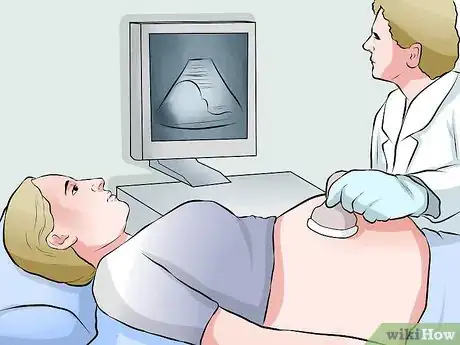


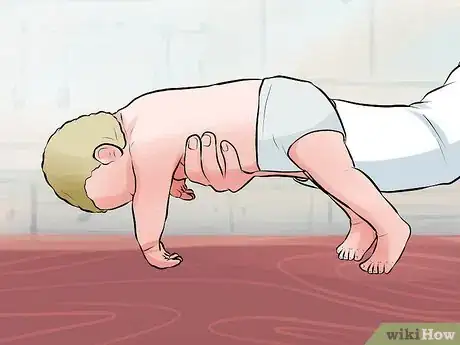
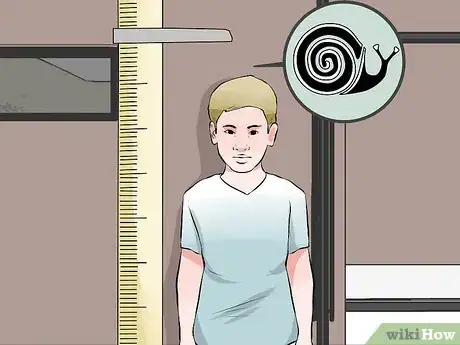
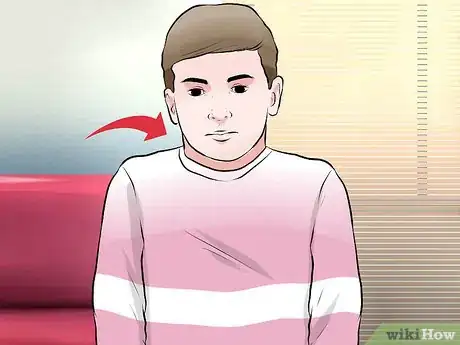
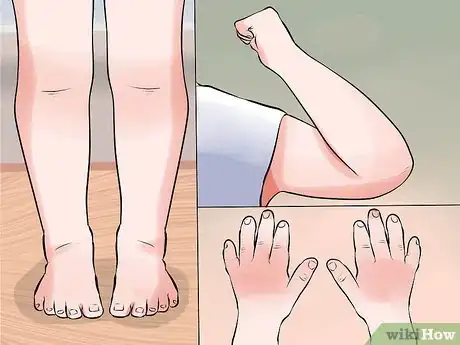
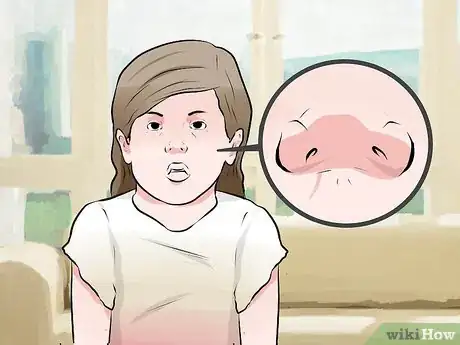
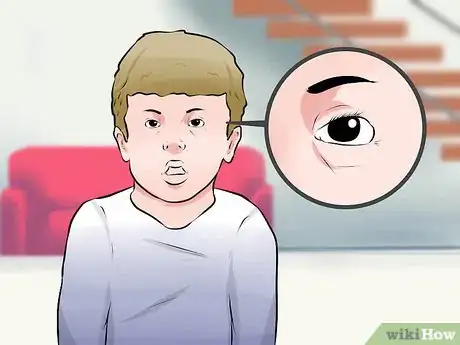
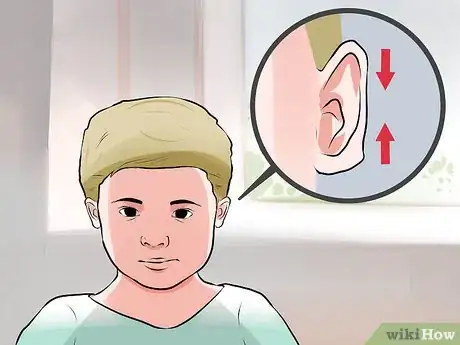
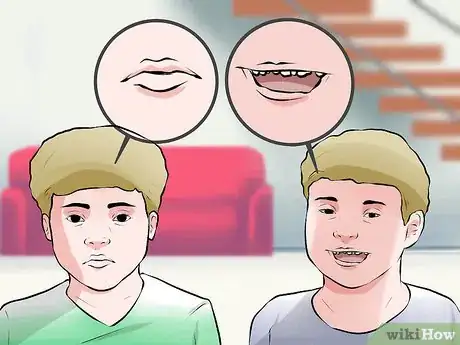


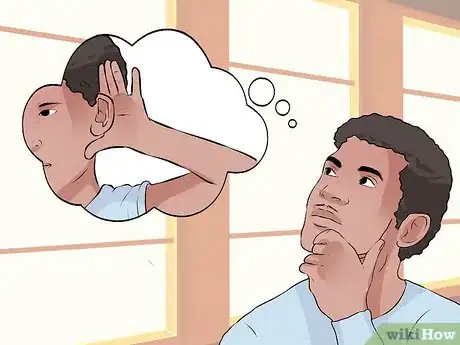
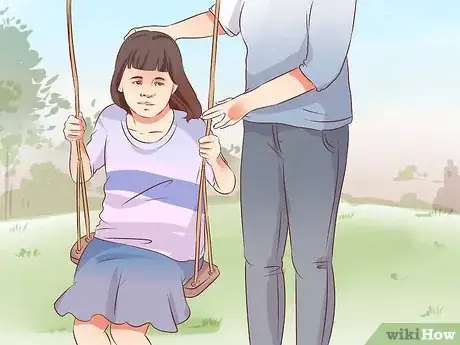


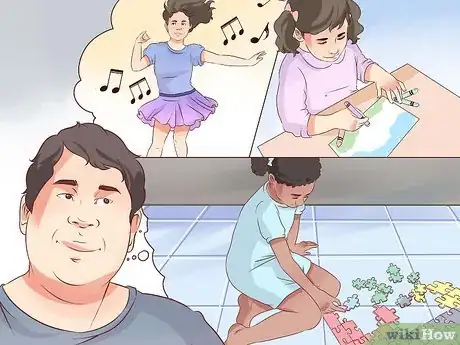


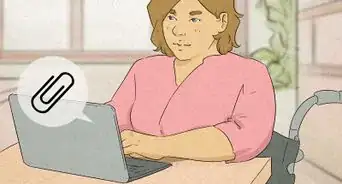

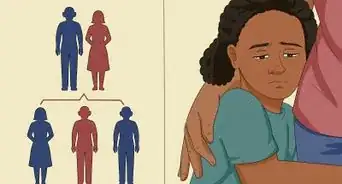
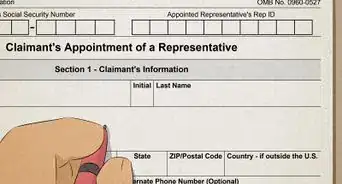
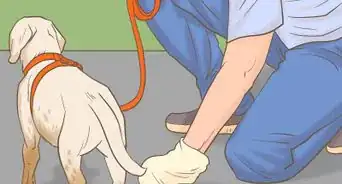


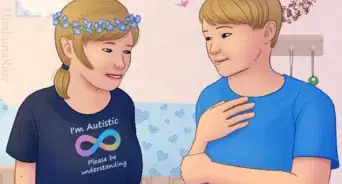
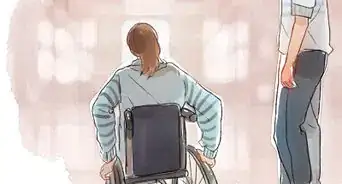
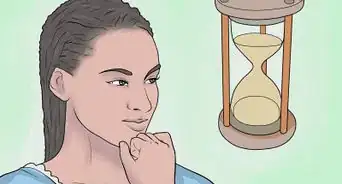

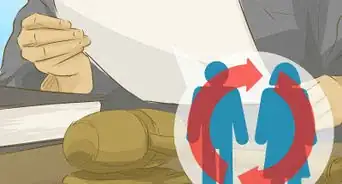















































Medical Disclaimer
The content of this article is not intended to be a substitute for professional medical advice, examination, diagnosis, or treatment. You should always contact your doctor or other qualified healthcare professional before starting, changing, or stopping any kind of health treatment.
Read More...